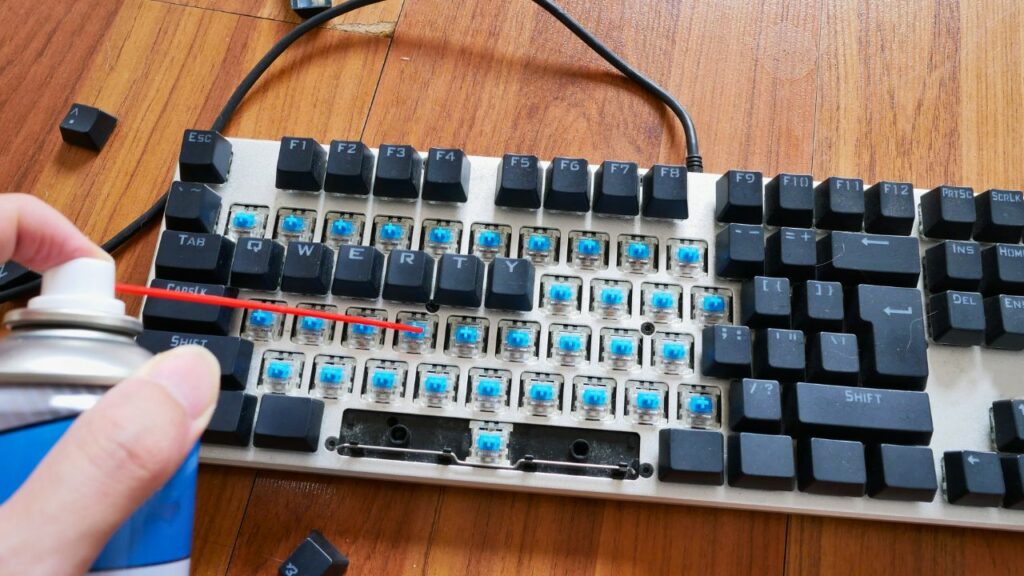
Are you looking for an enduring gaming keyboard? We’ve all been there – investing in the latest and greatest gaming keyboard only to find it starts to malfunction after a few months of use. But just how long do gaming keyboards last? In this article, we’ll answer that question and also provide some useful insights on how to extend the lifespan of your gaming keyboard. From learning about the different types of keyboards available to finding out which features make the biggest difference in durability, we’ll cover everything you need to know. So read on and get ready to get the most out of your gaming keyboard!
What Makes Gaming Keyboards Different Than Regular Keyboards?
Before we dive into how long gaming keyboards last, it’s important to understand what makes them different from regular keyboards. In short, gaming keyboards are designed with gamers in mind. Featuring top-of-the-line features and technologies, these keyboards have much more to offer than a regular keyboard. Mechanical switches provide a more tactile and responsive keyboard that is perfect for first-person shooters. Anti-ghosting technology prevents multiple keystrokes from being registered all at once, reducing lag when playing fast paced games. Programmable keys can also be custom programmed to execute complex macros quickly and easily. All of these features make gaming keyboards not only more durable but also able to last years with proper maintenance. For a full explanation of the differences check out our article What’s the Difference Between Gaming Keyboards and Regular?
How Long Do Gaming Keyboards Last?
When it comes to longevity, the lifespan of gaming keyboards varies greatly depending on a few key factors. Quality of construction, type of key switches used, and amount of use per day are all important considerations when determining how long your gaming keyboard can last. Generally speaking, most gamers can expect their gaming keyboard to last anywhere from three to five years with adequate care and maintenance. However, this range can be extended or shortened depending on the above factors.
For example, if you opt for a higher quality model with mechanical keys and use it frequently (e.g., more than 10 hours per day), then you may need to replace your keyboard sooner than three years. Conversely, if you purchase an entry-level model with membrane keys and only use it for an hour or two per day then your keyboard could easily last five years or longer.
Tips For Prolonging The Life Of Your Gaming Keyboard

Now that we know how long most gamers can expect their gaming keyboard to last (three to five years), let’s discuss some tips for prolonging the life of your own gaming keyboard:
1) Clean your keyboard regularly – Dust and dirt can accumulate on your keys over time which can lead to sticky keys or even broken switches. To prevent this from happening be sure to clean your keyboard regularly using compressed air or water (if necessary).
2) Invest in a good quality model – As previously mentioned, higher quality models with mechanical keys tend to last longer than entry-level models with membrane keys so it may be worth investing in a good quality model if you plan on using it frequently or for extended periods of time.
3) Take advantage of warranty coverage – Most gaming keyboards come with some form of warranty coverage so be sure to read through the terms carefully and take advantage if you need repairs or replacements down the line.
4) Avoid liquids around your keyboard – Spills happen but they can be disastrous for your keyboard if not addressed immediately so be sure to keep liquids away from your setup at all times!
5) Don’t leave food around – Food crumbs can get stuck between the keys which can lead to sticky keys and other issues so avoid eating near your setup whenever possible.
6) Use a wrist rest – If you find yourself typing extensively on your gaming keyboard then consider investing in a wrist rest as it can help reduce strain on your wrists over time which leads less wear and tear on the keys themselves.
7) Store properly when not in use – When not in use make sure that you store your keyboard properly by using a dust cover or unplugging it completely (if possible). This will help reduce dust buildup which could cause problems down the line.
Factors That Affect Gaming Keyboard Lifespan
When it comes to gaming keyboards, their time under the spotlight isn’t just about the RGB lighting—it’s also about how long they’ll last before the keys start fading and the ‘W’ starts sticking. If you’re clocking in hours on the daily, it’s a given that your keyboard is going to show signs of wear quicker than the casual player’s setup.
Yet, intense gaming sessions aren’t the sole factor in the lifespan equation. Consider the craftsmanship: it’s the distinction between a disposable trinket and a durable collectible. Premium keyboards command higher prices, but they also promise resilience with materials designed to endure the rigors of relentless keystrokes.
Your gaming cave’s climate matters too. Is your keyboard basking in the sun, or is it marinating in a snack-laden, dusty desk? Keeping it in a clean, temperate spot can prevent the electronics from going haywire.
And for those extra bells and whistles? Yes, we’re looking at you, customizable macro keys and that underglow lighting—these high-tech add-ons can be the first to fizzle out, depending on how well they’re made. Especially when considering LEDs, where going full brightness all the time can send them to an early grave.
The nitty-gritty of what’s under each keycap matters too. If your keyboard boasts mechanical switches, you’re in luck—these little guys are built like tiny tanks. But if you’re on the membrane side of the fence, prepare for a softer, potentially less enduring experience.
Let’s not forget the role of the manufacturer’s updates, which can be a game-changer for your keyboard’s longevity, ironing out bugs and keeping things running smoothly—or, sometimes, causing more problems than they solve.
Bottom line: A gaming keyboard’s lifespan swings from ‘quick exit’ to ‘end-game boss’ based on your gaming habits, the quality of its build, and how much TLC you give it. Treat it right, and you’ll be in it together for the long haul.
Guide to Choosing a Gaming Keyboard That Goes the Distance

Scouring the market for a gaming keyboard that won’t let you down mid-match? Pay attention to build and material quality first—these keyboards need to take a pounding and keep on responding. For those who live by the WASD keys, mechanical switches are a game-changer, offering that quick, tactile response we crave.
But it’s not just about the keys. Look for additional perks like customizable backlighting to suit your mood or setting, and programmable keys to execute complex commands with a single stroke. And macros? For the strategic player, they’re a secret weapon, letting you automate sequences to stay ahead of the competition.
Why shell out for a top-tier keyboard? It’s simple. These keyboards are in it for the long haul, thanks to their superior build and components that endure. The benefits are clear: more features and a sturdier design means a seamless, immersive gaming experience that lesser keyboards can’t hold a candle to. Check out our in-depth guide to see exactly what sets these high-end peripherals apart.
Troubleshooting Your Gaming Keyboard: Fixes for Sticky Keys and Worn Out Keycaps
Gamers know the drill—after countless battles, the keyboard can start to show its scars in the form of sticky keys and faded keycaps. To dodge these gaming pitfalls, invest in a keyboard that’s built to last and stay vigilant for wear and tear.
Keeping your gaming tool clean can make all the difference. Skip the liquids and go for a tech-friendly approach with a cotton swab or microfiber cloth slightly dampened with isopropyl alcohol. A gentle swipe over the keys can keep them responsive and in top form. Just be sure to let it dry completely to prevent any electronic mishaps.
Hit a snag with sticky keys? Don’t let it slow your roll. Turn off and unplug your rig, pop off those keys with a keycap puller—careful, now—and give them a spa day with that alcohol swab. Dry thoroughly, and you’ll be back in the game without that gummy resistance under your fingertips.
And if your keycaps have seen better days, you’ve got options. Temporary stick-on caps can patch up the problem in a snap for a quick fix. But for a solution that sticks, replacing the keycaps is the way to go. It’s not just about aesthetics—crisp, fresh keycaps can restore that satisfying tactile feedback that gamers crave. Not all keyboards make it easy, but for those that do, it’s a worthy upgrade.
Whether it’s routine maintenance or a full keycap operation, a little TLC can keep your gaming keyboard in it to win it.
Conclusion
In conclusion, while there is no definitive answer as to how long do gaming keyboards last as lifespan varies depending on several factors such as quality construction, type of key switches used etc., gamers should generally expect their investment to last anywhere from three to five years provided proper care is taken throughout its life cycle. By following the tips outlined above such as cleaning regularly and avoiding liquids around it etc., gamers can ensure that their investment lasts as long as possible!